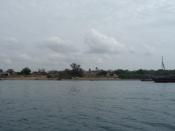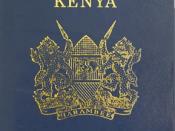With what was initially thought to be a feasible resource extraction proposal, has in turn lead to an onslaught of both economic and social uncertainties among more then five thousand Kenyans. Tiomin Resources, a Canadian based mining company, has shown a ferocious interest to construct 3 titanium based extraction mills along the Indian Ocean within the residence of the economically struggling providence of Africa. The proposed site(s), which rest in the fertile sand dunes along the Kenyan Coast, are thought to hold / embody one of the largest supply(s) of both titanium and zirconium bearing minerals in the world. Despite what stands to be both an economical and social jackpot for one of the largest mining Corporations in the world, has in turn generated a spin off and or threat of both economic and environmental externalities from formulating in the near future. Among the focal points of major concern(s) rest the vantage points of two distraught parties.
With more than ten thousand small-scale farmers in threat of being forced of their native soil, Kenyan's argue the feasibility dynamics of such proposals aren't socially balanced. Tiomin Resources rebuttals by addressing the profitable socioeconomic impact their proposal presents if operations where established in the financially dying province of Africa. As this heated debate continues, it soon becomes a question of assessing the feasible equity each party is willing to negotiate for. Not only is it imperative to question the long-run economical balance of such proposals but so to be it fitting to address the adverse effects such operations would have on the surrounding environment & short - run economical balances.
The dominant factor supporting Tiomin recent proposals to excavate within the titanium-rich sands of Kwale beach resides in the operations estimated economical worth. The three proposed sites which outlier the small coastal communities of Shimoni, Mombassa, and Mamburi are estimated to have 15-year extraction duration capable of producing in excess of 18 million tons of raw material on an annual basis. Furthermore, the $165-million dollar project would also generate more then 600 direct jobs resulting in the spin off of more then $25-million dollars being delivered to the struggling Kenyan economy. (Russell 1) Another aspect in support of Tiomin mining proposal highlights the areas geographic location. With more than thirty ports on the Indian Ocean, extraction via process time literally becomes cut in half. In addition, Tiomin has further intentions of constructing more then 5 processing mills less then 250 miles away from the Mamburi site, a proposition they feel will further jump-start and aid an end to economic struggles in the surrounding area.
"Aside from using water routes as means to transport and or relocate the extracted materials, we also have local access to more than 40 different rail stations: a commodity we're not use to having and or utilizing at such leisure." (Elder 22) Not only do the proposed mining sites hold an abundance of economic value but so to do the feasibility reports concerning the surrounding environment. The mines, which sit at less then 30 meters in depth, further support any threat extraction activities would have on the nearby water quality. Not only do the mines sit exceptionally low, in comparison to other projects and or extraction sites, they also have an estimated 85% purity level. Thus, dismissing the inherent threat of debris tailing and rock pilling, common environmental impacts that follow such extraction activities. Despite impressive, high profiled numbers and promises to the surrounding economy, many questions still remain unanswered. Underlining this assertion comes the futuristic doubts and uncertainties of the more then five thousand Kenya's literally being forced to hand over their land.
With Tiomins rigorous efforts to establish operations, the livelihoods among the thousands of Kenya's calling Kwale Beach "home" continues to remains in limbo. Among the variety of growing concerns, none of which is more dominant than the threat of economic disruptions. Because more than 80% of the proposed mining sites lie on and or sit in relative distance to rural farmlands, the inherent threat is the Kenyan economy stands to lose its prolific source of generated income. Aside from Tiomin offering less then $140 dollars an acre to all private landowner's, the number remains to both inadequate and equally skewed. Only a small portion of farmers rightfully own more than 10 acres of land in the local areas. Because of this, the compensation in which Tiomon is preparing to offering doesn't pose to be a valid investment for most if any of the localized farmers at all. Another aspect of equal measure focuses on the projects environmental feasibility. Two of the three proposed sites, Mombassa and Mamburi, both contain and or surround conservation parks. Shimba Hills, a national park located less then five miles outside of Mombassa, is thought to be dramatically impacted with the construction of such an operation. Another problem focuses on the Shimoni site and its relative distance to the conservation marina within the Indian Ocean. "These specific waters contain one of the world's largest concentrations of both dolphin and coral life. There remains without any question, the physical disruption to such a delicate environment would in fact be impossible to avoid." (Mungai 2) It is also expected that initial steps taken to mine would also disrup and dramatically impact the water quality in general location(s). By excavating raw titanium, the radioactive elements and cancer causing carcinogenic commonly found in such minerals also raises serious questions with regards to the projects overall safety. (ENS 1) As the issue remains to be debated upon, two parties feel they stressed enough adequate certainties to either promote or diminish the inherent notions to dig. As follows, it then becomes a matter of examining the social costs and or benefits verse the adverse effects such operations could possibly have on such a lavish environment. Despite what remains to be a clear-cut, straightforward issue, economic feasibility, valid compensation, and community interests need to be better evaluated for such a dramatic physical change and or transition to take place.
-SOURCES CITED- 1. Russell, P. Rosalind. "Kenyan Mining Project Brings Criticism in Spades." Canadian Spotlight News, November 20th 2000. Document Retrieved April 15th 2001 @ www.canadanews.about.com/gi/news/~a6et7e4.htm. (1-3) 2. Elders, R. Scott. "Mining and Economic Development in Kenya: At What Cost?" International Center For Human Rights and Democratic Development, February 2000. Document Retrieved April 14th 2001@ www.rights&democracy.org/02-05-00/ligio/kenmine/hmtl. (1-4) 3. Mungai, Naftali. "Titanium Mining in Kenya Digs Up Environmental Fears." Environmental News Service, April 5th 2000. Document Retrieved April 16th 2001 @ www.ens.lycos/ens/apr2000/2000l-04-05-04.html. (1-2)





